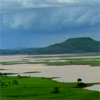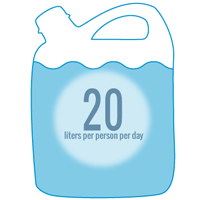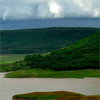
This post is a follow up to The Case for Water Diplomacy for South Asia (Ganges-Brahmaputra-Meghna Basin). The initial post describes the unique hydrology and water security challenges for the Ganges-Brahmaputra-Meghna (GBM) Basin shared by Bangladesh, Bhutan, China, India, Myanmar and Nepal.
The problem of water security in South Asia is rooted more in spatial and temporal variation of precipitation and flows, rather than absolute scarcity. If the skewed water availability in nature and the pattern of water requirement round the year can be brought closer to each other , water security for South Asia may not be a difficult target,.
The GBM basin needs interventions that can repair and prevent further ecological damage while providing sustainable water allocations to support the people of the basin. Some of these interventions are changes within institutions, economic approaches, or culture shifts. And while these may be important, they are not as immediately actionable and relevant as the need to push to evolve the process of how ecologically sound water engineering practices are approached and implemented in the basin.
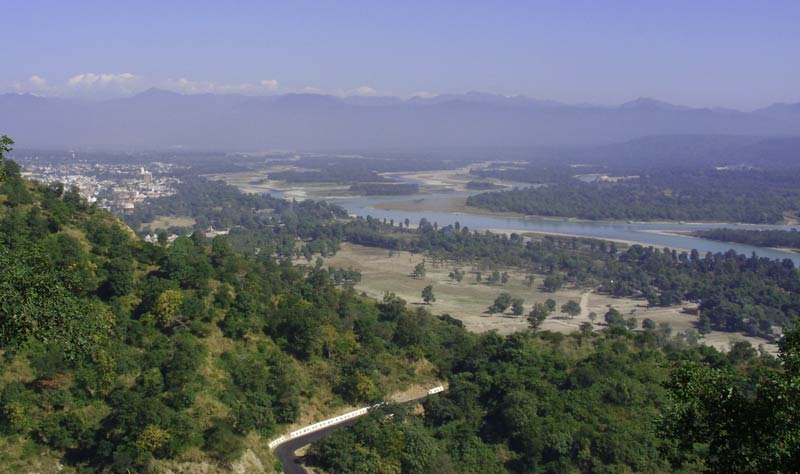
Ganges valley between Haridwar and Rishikesh, Uttaranchal, India. Wikimedia Commons
First, we need to accurately quantify the available water in South Asia. Making allocations of water for a purpose requires knowing how much there is. The complex geography and climate processes of the region make the assessment of water precipitation, flows, and timing particularly difficult to perceive and assess at the resolution needed for reliable decision making. Without such a reliable understanding, water allocation processes will be unrealistic. We cannot ensure any allocation, provide adequate water for human-well being, and protect ecological processes and services without better knowledge about the water we have.
Second, water pollution needs to stop. The reduced quality of polluted waters causes de facto reductions in water availability, whether for irrigation, industry, domestic supplies or ecosystem services.
Third, increased end-use efficiency, especially in irrigation, will increase the amount of water available for all other needs.
Fourth, ecosystem processes and services have been ignored in previous attempts to engineer water supply and power generation in both the Ganges and Brahmaputra sub-basins. Water related projects need to be evaluated in their economic viability on the basis of a basin-wide Strategic Environmental Assessment.
Fifth, likely impacts of climate change need to be assessed by developing appropriate regional climate models suiting the topographical peculiarities of South Asia, especially the Himalaya.

The unique biodiversity of the Terai region at the base of the Himalaya supports rare and endangered species of plants and animals. Wikimedia Commons
In the specific context of the GBM basin, several points of entry provide opportunities for a successful new water diplomacy intervention that can change the traditional reductionist framework of water engineering:
– We need to be able to accurately predict (model) and assess flows in the Himalayan rivers. For this, we need to create a hydro-meteorological database for the Himalayan uplands and mountains with spatial density comparable to that as recommended by the WMO for mountain areas. We urgently need to strengthen regional climate models specific to the orography of the Himalaya so that we can project and account for future climate scenarios and related hydrological parameters.
– We need to disabuse the notion that that these waters are nothing but a stock for immediate human needs and recognize that the Himalayan rivers are an interlinked flow of water, sediments and energy. The nature of the interaction among the three constitutes an important segment of river ecology in all parts of their respective basins, starting from the high mountains to the floodplains, deltas and estuaries of the rivers and the coastal areas. Modifications to the rivers may have significant impacts that can cascade throughout the system, impacting ecosystems and economies in unexpected ways. These interconnections needs to be considered and accounted for within the decision making process.
– We need better and more comprehensive identification and assessment of the diverse ecosystem processes and services of the Himalayan rivers in all parts of their basins – this is basic for developing ecologically informed and comprehensive methods for design and evaluation of water related projects. What do we do with sediment that accumulates behind storage dams? What are the impacts downstream from reduced sediment flow? How will a new project impact downstream ecosystems, their constituent processes, and vital services they provide?
– We need to accept that there will be high flows in a monsoon climate. An expected natural event is not an aberration and needn’t become disaster. The high flows can be a source of water for the off-monsoon periods and the flows themselves can support ecological processes. The need for dam storage may also include providing mock high flows that can support ecological needs. Once storage is planned in a way that can help ecosystems, economies, and people, there is more room for downstream impacts of a storage project to be positive for communities and the environment.
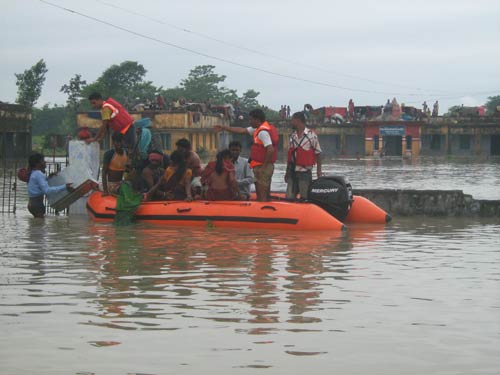
NDRF rescue operations during the 2008 Kosi Flood Wikimedia Commons.
– We need to accept the shifting lands. The GBM carries the highest annual suspended sediment load in the world, and sediment carried by streams and rivers results in geo-morphological dynamism in the foothills, floodplains and delta. The GBM delta has been constantly advancing southwards into the Bay of Bengal as the Bengal Fan, up to a distance of about 1000 kilometers. This dynamism and the morphological implications of large mass wasting events in the Himalaya, make the river channels subject to large scale shifting that traditional engineering has not adequately internalized. A policy for the sediments needs to be integral to the policy for the Himalayan rivers. Engineered solutions to water problems in this region need to account for and work with the shifting landscape.
– We must use stakeholder input from all users, including ecosystem services, to generate water systems engineering that optimizes and sustains ecosystem services in all parts of the basins for basin wide advancement of well-being, as uninformed efforts at the maximization of economic returns from individual projects have the potential to cause more harm than good.
– We need to acknowledge and plan for the reality that one day we will exhaust supply-side solutions and will need to achieve far greater efficiency for water use demand management across surface and groundwater use in all sectors. Identifying and enabling opportunities to research and implement these technologies should be a priority in water diplomacy efforts.
To accomplish this, we need new dimensions in the education of water systems engineers and hydro-diplomats within South Asia. Just as we need to develop new approaches and policies for sustainable ecological engineering for economic advancement and water security, we first need to prepare engineers and leaders to address these challenges for the water future of South Asia with confidence.

